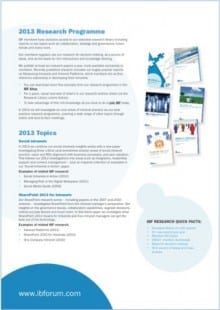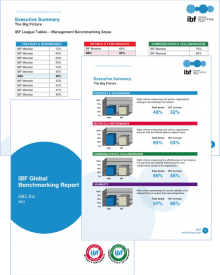My 10 digital workplace predictions for 2018
 For several years now, I have started my annual digital workplace predictions by scoring myself on how I did the previous year. After all, why pay any attention to my forecasts if the past ones are not reasonably accurate?
For several years now, I have started my annual digital workplace predictions by scoring myself on how I did the previous year. After all, why pay any attention to my forecasts if the past ones are not reasonably accurate?
Story so far:
2014: 7/10
2015: 7/10
2016: 8/10
2017: 7/10
Reflection on 2017
So, I almost gave myself a 9/10 for 2017 as I wavered over the x for predictions 6 and 8. While there has been progress in both areas, I cannot really say (hand on heart) that we have yet seen public and civic organizations transforming their digital workplaces (though they are progressing fast) and, while it is improving for sure, strong enterprise search is still, sadly, far from common.
My 2017 scorecard
| Prediction 1 | Digital workplaces seize on AI in the “intelligent workplace” | ✓ |
|---|---|---|
| Prediction 2 | Focus shifts from “firing up tech” to changing behaviour and culture | ✓ |
| Prediction 3 | Digital workplace strategy takes central role | ✓ |
| Prediction 4 | Intranets keep getting better and stronger | ✓ |
| Prediction 5 | The “centre of gravity” for work moves from physical to digital | ✗ |
| Prediction 6 | Public and civic organizations transform their digital workplaces | ✗ |
| Prediction 7 | Leaders influence (rather than control) as leadership becomes digital | ✓ |
| Prediction 8 | Quality search becomes common | ✗ |
| Prediction 9 | Workplace by Facebook disrupts the digital workplace industry | ✓ |
| Prediction 10 | Digital literacy becomes an essential competence | ✓ |
My digital workplace predictions for 2018
1. People analytics grows as software begins to monitor and track us all
A “Big Brother” range of software tracking services is starting to observe us all as we work. While this concept of the organization “monitoring” our every move, click and connection might sound sinister, it is inevitable. Why? Because the technology allows us to do so and, as management guru Peter Drucker once said, “What gets measured, gets managed”.
Tools like those from quantified workplace company Humanyze track who is talking to whom, which teams collaborate well and where the blockages are – and this arrival of people analytics will become more extensively used by HR, communications and operations. To some extent, national legislation that describes the privacy rights of workers will provide a counterforce but, over time, most of what we do in work will be visible, analysed and tracked – and this will remain (in most instances) as anonymous metadata.
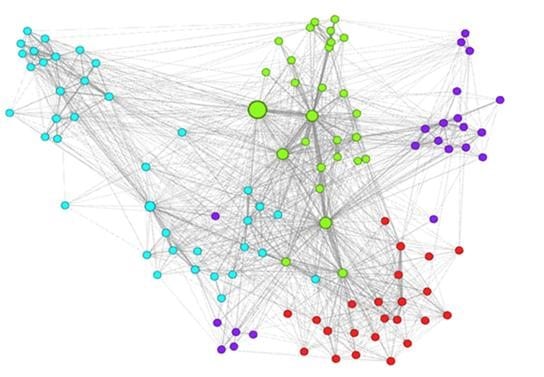
How Humanyze displays its people analytics.
2. Microsoft remains the enterprise platform of choice – despite decent competition
Remember Slack? In 2016 it was the talk of the town and was going to “change everything”. In 2018, Slack is accepted as another solid digital workplace service (just as Yammer has become) but is a long way from being a platform on which enterprises can build viable digital workplaces.
Yes, Workplace by Facebook has been the star of 2017, and with good justification given its Facebook pedigree and superb mobile services, but in 2018 Microsoft will still reign supreme as the enterprise platform of choice. The good news is that the technology providers like Slack, Box, Workplace by Facebook and Google Suite are providing strong competition, which means Microsoft has to keep innovating, collaborating and improving in order to retain its market share. (If anyone can explain to me what the IBM plan is though, I would be delighted, as it seems to be permanently struggling to remain relevant in the digital workplace.)
3. Employee experience plays a central role in a powerful digital workplace
User experience is now a staple component of both internal and external digital services in most large organizations and remains central to all digital service development. But there is a larger concept taking over the prime slot and that is “employee experience”, mainly because this places the developers in the shoes of employees as they move through their working day.
As most organizations discover though, getting this right is hard work as many factors will fracture the ideal smooth, natural flow of digital connection that we would wish employees to enjoy throughout the working day. Verizon (shown below) has done a great job in thinking through the whole experience from the moment someone logs onto their system or enters a facility, to the end of their digital or physical workplace experience, and then trying to identify and fix the points of failure.
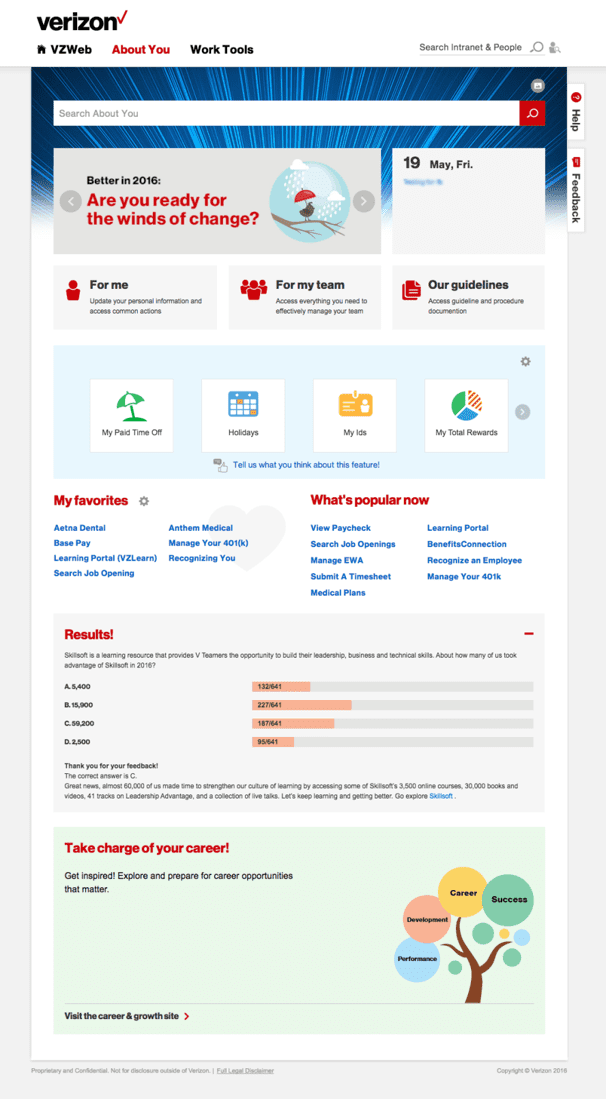
Verizon’s digital workplace
4. Intranets have never been in better health – and (surprisingly) email also remains popular
Barely a day goes by without us hearing that “intranets are dead – and the new digital XYZ is born”. But as we journey through 2018, we will notice that high-grade, functionally rich, well-designed intranets are still an essential application and often the front door to the wider digital workplace within any medium/large company or public organization.
From what we see across many DWG members, intranets are still in great good health and here to stay for many years to come. The reason why intranets have remained strong for 20 years now is that they evolve as work evolves. Here is a strong example from 3M.
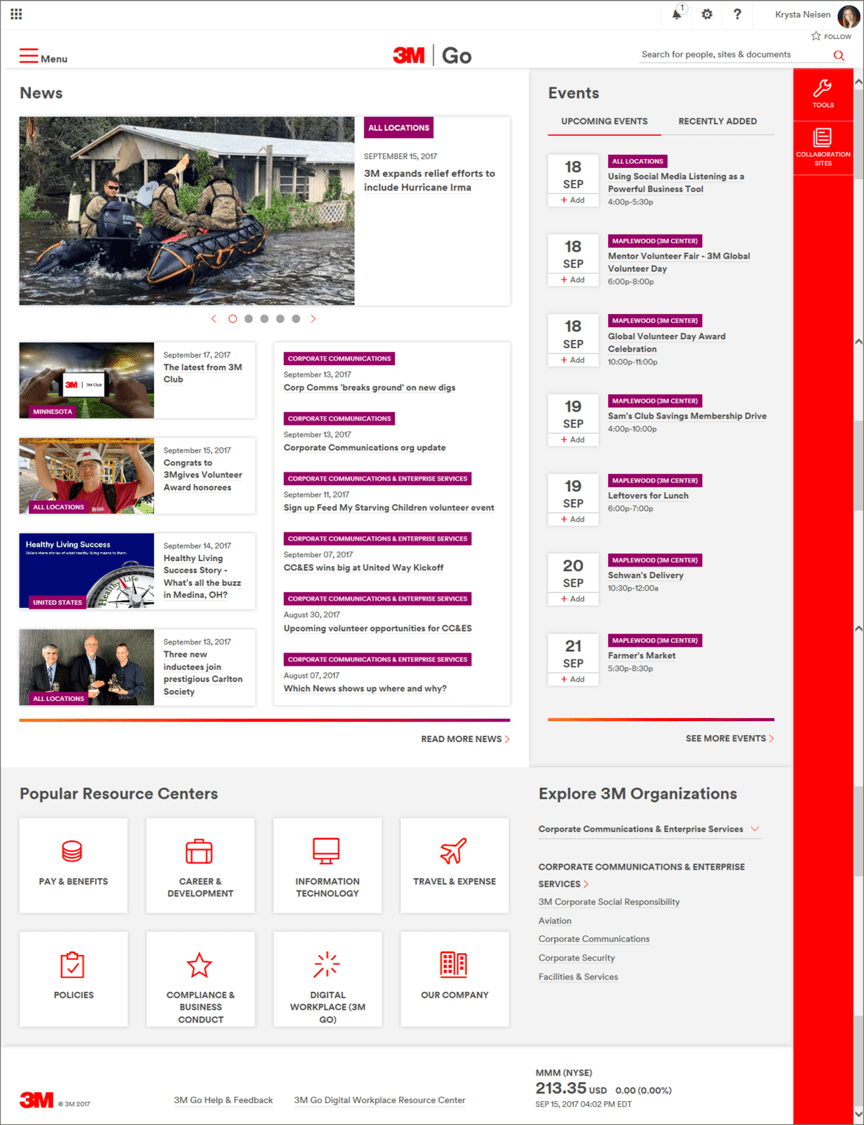
How 3M approaches its intranet
5. Collaborative tools encourage a shift from individual ego to team contribution
In an interview for our podcast, Digital Workplace Impact, David Meza, Chief Knowledge Architect at NASA, mentioned a fascinating but logical observation of a pattern he has identified in the evolving NASA workforce: younger people are less driven by individual ego in their work and more attached to the performance and results of their teams.
As more young people, who increasingly have been educated using collaborative tools, enter the workplace, they assume that shared working, knowledge exchange and collaboration are standard processes in work. This represents a systemic shift from individual to team, enabled through technology, and the ripple effects will be substantial over the coming years.

6. AI and the intelligent workplace produce hype and reality in equal measures
There is a lot of conversation around (as well as beginning to be some impressive delivery from) chatbots, natural language and speech recognition in our digital lives, but from an enterprise stance there is still (mostly) far more noise than actual delivery from AI. In coming years, AI will of course have a profound effect on how everyone works, as well as in determining what work humans actually continue to do, but for 2018 the reality of AI will be at most steady and modest
More intelligent search algorithms, better expertise locators and real-time data on team performance will continue to arrive in places. However, our focus should be to remain well informed and yet discerning about the true value for our organizations of the intelligent workplace. It will be important not to fall for the marketing hype or to worry excessively that we will somehow be left behind as the AI world races ahead of us.
7. Leaders lacking excellent digital literacy will struggle to thrive (or even survive) in the workplace
The capability of leaders at all levels to navigate the digital world of work expertly (or rather the lack of it) is a constant talking point for digital workplace directors and intranet managers. “What is the level of digital literacy of the senior leaders in your company?”, I find myself frequently asking. Upward-mentoring programmes, shifting demographics as millennials rise in the organization, and development systems for leaders, are at last beginning to raise the digital IQ of leaders. This is good, essential and will continue at pace.
Leaders will be required to share their work and views, and to operate in more collaborative ways. “Working Out Loud” (as it’s called) is becoming more common, a great example of this being Accenture CEO Pierre Nanterme, who leads what he calls a “virtual organization” of 400,000 people. The dangers lie for leaders who remain digitally illiterate. Not only will their careers be blighted by their digital deficits but progressively such leaders will become extinct.

8. The digital workplace rises in stature – no longer the poor relation to external digital
The digital world of work has not attracted (and will most likely never fully attract) the level of investment that external customer-facing services have enjoyed for many years. So the internal digital will remain the poor relation. But the balance has been shifting for two years now as organizations realize they cannot be effective externally if they are not equally effective internally.
Evidence for this can be found in the many large organizations investing strongly in strategic digital workplace programmes and in the hiring of a Director of Digital Workplace or Chief Employee Experience Officer. Annual surveys of CEOs by the well-respected Conference Board have, since 2015, been showing how much importance is now placed on staff, internal and cultural issues by CEOs, with leaders increasingly focused on culture, people and how their organizations work. For the likes of DWG clients and members such as ING, Estée Lauder, IKEA, Accenture and Adobe, this has become a staple of their strategies, and this rebalancing towards the internal from the external opens up exciting opportunities for digital workplace teams to set bold visions and make the case for the ongoing investment such vision requires.
9. Younger workers want a clearer distinction between “work” and “life”
Demographic changes often produce surprises. The latest slightly surprising trend, which I believe will only grow stronger in 2018, is the desire amongst younger workers to seek (and secure) a clearer demarcation between their work and the rest of their lives. Perhaps spurred on by the recent enthusiasm for wellness and mindfulness, plus a fear of digital addiction, those in their 20s (mainly) leave work for the day and switch off from their digital workplaces.
Look around on public transport in major cities and you will likely see the younger travellers reading, listening to podcasts, books and music – and less hooked into Yammer, Slack and email during their commute. A new badge of wellbeing will be your ability to switch off from the digital workplace when work for the day is done. Strangely, remaining digitally “on” 24/7 is becoming more a feature of older workers while the younger workers don’t regard checking their emails and Yammer messages on the journey into work as either a smart or healthy use of their time.
10. Workplace by Facebook’s new status spurs better mobile frontline services across the industry
The most celebrated stories arising from the arrival of Workplace by Facebook have been at the frontline – Starbucks, Renault and Walmart, for example. This is because they have involved a cadre of staff who were so long left out in the “digital desert” while organizations focused (excessively) on office-based people. This has been transformed through Workplace by Facebook, due in large part to the excellent mobile experience it offers.
And as this service expands (and I see no reason not to expect strong growth as new functionality is released by Workplace by Facebook), the requirement for all digital workplace applications (intranet, unified communications, HR, collaboration, document management, etc) to include superb mobile deployments will only increase. This remains a competitive advantage for Workplace that Microsoft and others must match – and fast.
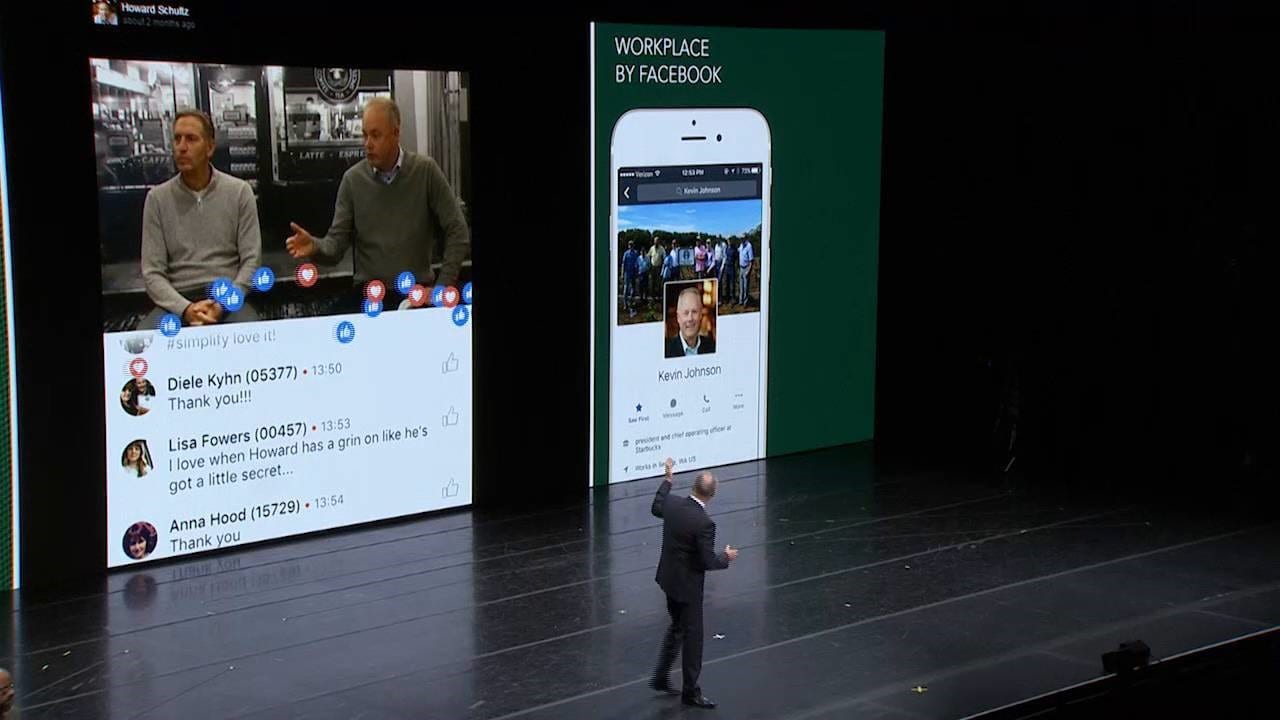 Howard Schultz, Starbucks Founder appearing on Workplace by Facebook.
Howard Schultz, Starbucks Founder appearing on Workplace by Facebook.
RESEARCH AND RESOURCES
● NEW! FREE REPORT: Digital workplace integration: Key approaches to drive benefits
● FREE REPORT: How mature is your digital workplace?
● FREE EXECUTIVE SUMMARY: Becoming a digital workplace leader
● Blog: What is the “Digital IQ” of your leaders?
● PODCAST (featuring Workplace by Facebook): Facebook, Oxfam and ‘digital leapfrogging’
TAKE THE NEXT STEP
How does your Digital Workplace compare?
Categorised in: Digital workplace
